Floor Insulation Cost
Last updated 24th July, 2025
Most people understand the value of loft and wall insulation and double-glazed windows. However, when it comes to insulation, the floor is frequently overlooked.
This guide will explain the average cost of installing underfloor insulation, what factors influence the cost, what's associated with installing underfloor insulation, how and where to find and hire a contractor to install your underfloor insulation and what questions to ask them.
Depending on the size of your property, floor insulation can cost anywhere between £500 to £4,700.
Let's get started below.
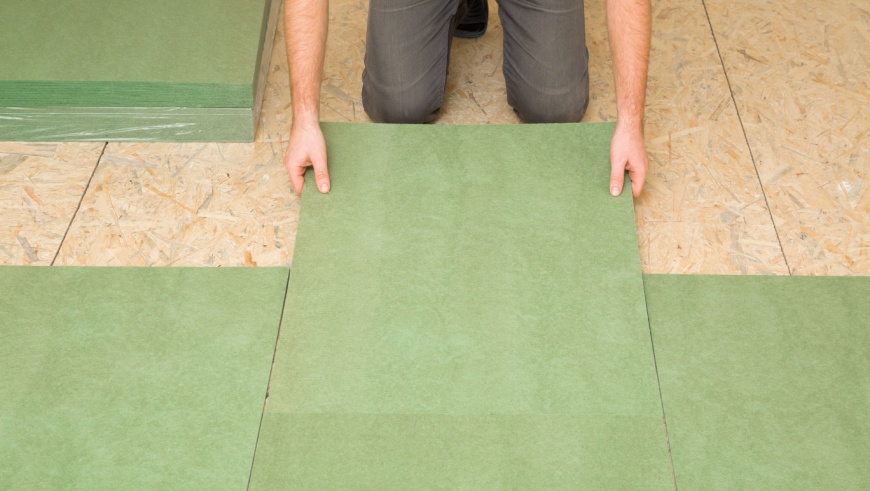
Table of Contents
- How much does floor insulation cost?
- Additional costs of underfloor insulation
- Labour cost to install floor insulation
- Factors that drive floor insulation costs
- What does insulating a floor involve?
- Type of insulation
- DIY floor insulation
- Building regulations for floor insulation
- Planning permission for floor insulation
- FAQs
- How to find & hire a floor insulation installer
- Sources
How Much Does Floor Insulation Cost?
Several different factors can influence the overall cost of installing underfloor insulation, such as the size of the room, as more insulation will be required, making it more expensive. As an example, as you can see, insulating the floors of a 60-square-metre flat is likely to cost between £500 - £750.
On the other hand, a terraced house will cost around £800 - £1,150 because it is more extensive.
Installing floor insulation in a small flat typically costs between £500 - £750. A terraced house will typically cost between £800 - £1,150; a semi-detached house would then cost between £1,200 - £3,000, and a detached house will cost between £1,600 - £4,700.
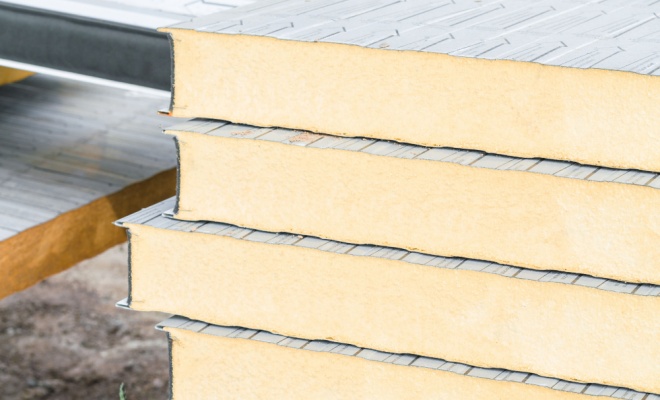
Floor insulation boards are typically phenolic foam, polyisocyanurate, polystyrene, and EPS and come in various qualities, sizes, and prices. Depending on where you want to put them in the room. The greater the thickness of the insulation board, the less heat manages to escape.
The thickness of flooring insulation boards can range from 25 to 150 mm, although 70mm foam or 150mm mineral wool will meet minimum regulations.
Industry standard insulation boards are available in sizes of 600mm by 1200mm, although custom fit measurements are also available. The average cost of floorboards ranges between £10 - £20 per square metre.
Floor Insulation Prices
| Size of Job | Cost |
|---|---|
| Small flat | £500 - £750 |
| Terraced house | £800 - £1,150 |
| Semi-detached house | £1,200 - £3,000 |
| Detached house | £1,600 - £4,700 |
Additional Costs of Underfloor Insulation
When installing insulation to your floor, you may decide you want to get other jobs done while the tradespeople are in your home, or other costs may come up that will add to the overall cost. Here we will go through the different additional costs that may come up when installing insulation to your floor.
Underfloor Heating
There are a number of underfloor heating options available, which will certainly benefit from having a floor insulated.
Electric underfloor systems typically cost around £60 per m2 for electric mats and £75 per m2 for a loose-wire system. Water-based underfloor heating systems are typical £100 per m2, with whole-house system installations likely to cost £2,500 or more.
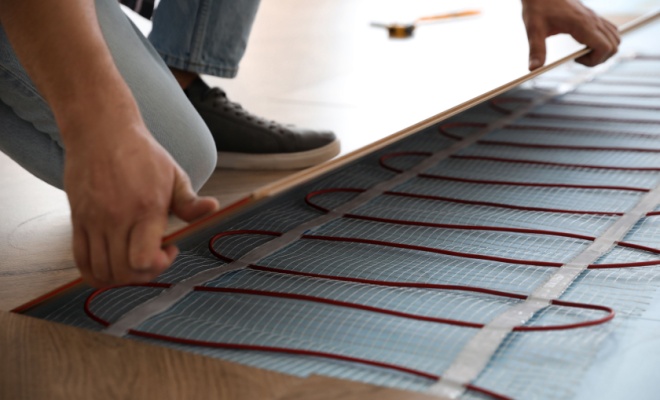
Wooden Floor Installation
Installing laminate flooring in a standard size room (20 sq. m) typically costs around £600. The price includes removing and preparation of the old flooring and the supply and installation of the laminate flooring.
Oakwood flooring is the most expensive natural wooden flooring, costing around £1,100 to install. The average flooring cost varies based on area, labour cost, style, and material price per square metre.
Floor Tiling Cost
The average cost to fit floor tiling in a medium-sized room is around £600 - £700. This price involves the price of the floor tiles, grout, self-levelling compound, and labour. The cost assumes mid-range, standard-sized tiles costing £25 per square metre or less and a standard-shaped room with no gas engineers or electricians needed to remove/replace appliances.
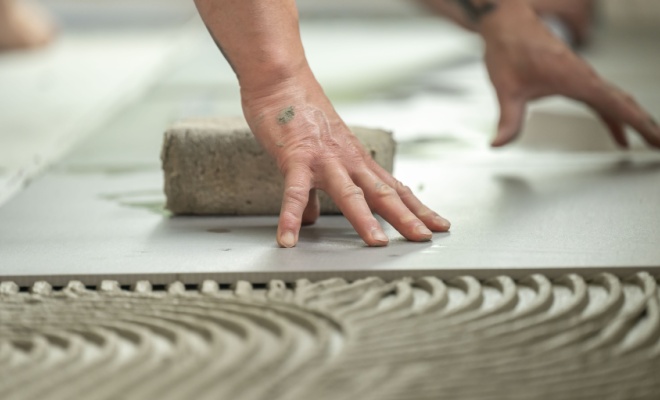
Laminate Flooring
It should cost around £10 - £12 per square metre for a professional to install laminate flooring. Prices may differ depending on the type of laminate you select. The price for a tradesperson to complete the fitting can be heavily influenced by the size and shape of the room, which determines the level of difficulty and time required to complete the work.
Carpet Installation
Based on a standard 15m² room, the average carpet fitting cost is between £330 and £600, including both the carpet and underlay, along with associated labour fees.
Costs can increase depending on the size and materials used, with the likes of a luxurious wool carpet adding extra comfort and insulation.
Soundproofing Floors
In addition to floor insulation, soundproofing is a job worth doing at the same time, especially as you will already be removing any floor coverings to carry out the work.
On average expect to pay around £400 to £1,000 depending on the size of the floor area, although premium options are also available for those with a higher budget available.
Underfloor Insulation Cost Breakdown Calculator
The total cost for floor insulation for a semi-detached house: £1462
Materials
£731
Labour
£731
Cleanup
£0
Labour Cost to Install Floor Insulation
The labour costs can affect the overall cost of insulating your floor as it is a big part of the cost. Here we will go through the labour costs to install insulation to your floor, as well as the amount of time it will take to complete.
Hiring a professional floor insulation specialist will set you back at least £770, depending on the size of the floor space and the price of the materials. However, if you decide to insulate the floor yourself, the cost for wooden floor insulation is only £100 for the floor insulation boards and an additional £20 for the materials needed to fill the gaps between the floor and the skirting boards.
Depending on the size of your property, installers will typically complete the installation in one day. For example, a small flat will usually take one day, a terraced house will take one to two days, a semi-detached house will take two to three days, and a detached house will take three to four days.
If you want to hire a professional, a handyperson or an insulation installer will be able to do the job quickly. A tradesperson's day rate will be between £120 - £160.
It is also worth noting that prices may be higher in London and the South-East, where labour rates are typically 10–20% above national averages.
Factors That Drive Floor Insulation Costs
When having your floor insulated, you might have to have additional work, which will add to the overall cost. Here we will go through the different cost affecting factors to know what to expect when insulating a floor.
Electric Re-Wire
In some cases, this is required to not intrude with the insulation once installed; the average cost of an electrician is around £150 per day in labour, though many insist on working in pairs for safety reasons and completing work faster.
Due to this, this price may increase to £250 per day in labour, but this will largely depend on the amount of electrical work being carried out. If you need an electrician, it may be essential to consider installing a loft light, especially if you believe you will use your loft space more frequently once the insulation is complete.
Moving a Radiator
This may be needed, so the radiator does not get affected in the process. Your goals will determine the overall cost of the job. You should budget £40 - £60 for materials and an additional £80 - £120 for labour to move the radiator.
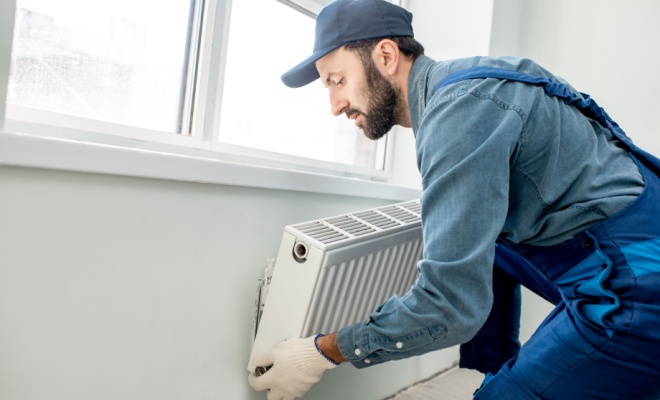
The ease of relocation will significantly impact the amount of time it takes to move the radiator and the overall cost of the job. Is it necessary for the pipework to pass through plaster, coving, skirting, or brickwork? Every impediment complicates the job, and these are the factors that will add time and cost to the job.
Bleeding is always required after successfully moving your radiator. Bleeding a radiator will only take about 30 minutes but will cost an extra £40 - £50.
Painting Skirting Boards
Your skirting boards may become slightly damaged or need new paint throughout the process. Compared to painting a wall, painting skirting boards is even more labour intensive because it is a fiddly and slow process. This means that the prices you'll be quoted will vary significantly across the country depending on your location and the skill level of the painter.
Depending on the labourer you hire, it will cost between £200 - £300 to have your skirting boards painted.
Size of Room
The more insulation you need for a larger room, the more expensive it will be. For example, as shown in the table, insulating the floors of a 60-square-metre flat is likely to cost between £500 - £750.
On the other hand, a terraced house will cost between £800 - £1,150 because it is more significant.
New Skirting, Reduce Door Heights or Move Radiators
When you insulate a concrete floor, the floor level rises. As a result, skirtings will need to be removed and reinstalled, and radiators may be relocated. A carpenter can assist you in raising your door and removing and replacing your skirtings. Carpenters usually cost around £15 - £22 per hour, or £120 - £176 per day.
A heating engineer or plumber can relocate your radiators. A plumber will charge between £40 - £80 per hour, or between £320 - £680 per day. A heating engineer will charge between £30 - £60 per hour, or between £240 - £480 per day.
Location
If you live in or near London or the Southeast of England, you will most likely pay more for services. You should factor in 10% to 20% of a tradesperson's installation cost.
What Does Insulating a Floor Involve?
Insulating a floor entails insulating material underneath the floorboards to reduce heat loss through the floor and into the ground. This route accounts for approximately 10% to 20% of a house's heat loss. Insulation also prevents draughts from rising through the floorboards. Furthermore, the household should think about insulating the gaps between the skirting boards and the floor, which will help to reduce draughts.
But what exactly does insulating a floor entail? We'll go over anything involved in insulating a floor here so you know what to expect.
Insulation can be installed either during the initial construction of the property or as a later retrofit. If it is done as part of the construction process, the entire task becomes much easier, and you can have to install more cost-effective insulation.
If your insulation is being retrofitted, you will have fewer options, and the entire process will be more expensive because time must be spent gaining access to the floor before you can do something about upgrading the insulation. This will significantly increase the project's time and cost.
Floor insulation is frequently far trickier than insulating other areas of the home. Because the ground floor underneath a house is usually warmer than the air above it, it should be lower on your list of insulation priority areas than walls and roofs. However, it makes sense to allow retrofitting, especially if you have a suspended timber floor, to prevent cold air from circulating and rising through the floor.
In general, the job will entail removing the existing floor, trying to add the insulating element, replacing the floor, and attempting to make any necessary repairs. However, if the flooring is solid and must be raised or other corrective action must be taken, the job may become more complicated.
Insulating concrete floors costs significantly more than suspended wooden floors due to excavation or overboarding, which may significantly increase the overall price.
When installing floor insulation, keep in mind the U value, which defines how much insulation you must have. The U-value requirements are established by Building Regulations/Standards.
The project's location determines these. The U-value refers to the levels of insulation required when performing building work, whether for new construction or renovation. The location, whether in England, Scotland, or Wales, the building type and whether this is domestic or non-domestic, and the application, like the floor, wall, or roof. U values are typically expressed in terms of W/m2K.
Type of Insulation
Insulation is very inexpensive, but the sort you choose will affect the cost. There are several kinds of floor insulation, which include:
Insulation Blankets
Blanket insulation is purchased in rolls. It is a type of insulation that is widely used. For example, if you are trying to install insulation from your basement, you can use blanket insulation between joists.
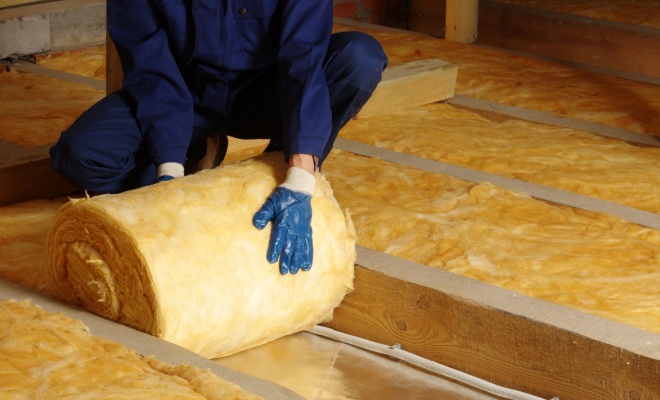
Blanket insulation comes in felt, rock, mineral fibre, and glass varieties. Sheep's wool is a more expensive material.
Felt Insulation
Felt insulation is a low-cost option. Thermal clay felts are fire-resistant and soundproof.
Rock Insulation
Rock mineral is created from various materials, and rock is melted and formed into fibres. As a result, it is both fire-resistant and sound-absorbing.
Wool of Mineral Origin Insulation
Rock wool and stone wool are examples of this. In addition, it contains a high percentage of recyclable materials and is an excellent soundproofing material.
Glass Insulation
Glass insulation is created from sand and recycled glass. It holds a lot of air pockets which is also good at soundproofing.
Sheep's Wool Insulation
Sheep's wool is a natural fibre that does not irritate the skin or cause breathing problems throughout the installation. It also soaks up and works well as a soundproofing material.
Board of Insulation
If you have eliminated your floorboards, you can cut the insulating board to size and place it between the joists.
Insulating Boards with PIR Sensors
These boards are installed on top of a concrete floor. They are small and lightweight, making them simple to install.
DIY Floor Insulation
The floors in older homes frequently allow heat to escape, but thankfully, effective floor insulation can stop this and reduce dampness. And, because it is possible to preserve its beauty while insulating a floor, it is a project worth completing even in historic homes.
Having a professional insulate your floor will make the job easier because you will be relieved of the stress of DIY and will have peace of mind knowing the job is done correctly. However, hiring a professional will cost you a lot of money, whereas DIYing the project will save you a lot of money. We will go over how to DIY floor insulation in this article.
Not all home insulation work must be done by a professional; it may be less expensive to do the smaller jobs yourself. For example, with a tube of sealant purchased from any DIY store, you can quickly seal the gaps between floors and skirting boards to reduce draughts.
It's even simpler to insulate your timber floor if you have access to an unheated cellar or basement space beneath it. But, first, check that the joists that support the floorboards are in good shape and do not show signs of wet or dry rot.
If the joists are in good condition, you can install insulation between them and secure them with netting if necessary. To provide fire resistance, the basement's 'ceiling' should then be plasterboard fixed directly to the undersides of the joists – and you can then fit more rigid insulation underneath the 'ceiling' to benefit from even more insulation.
Several homes will have a solid concrete ground floor, especially new ones. When it is time to replace it, it can be insulated, or rigid insulation can be laid on top. Suspended timber floors are most common in older homes. You most likely have a suspended timber floor if you have air bricks or ventilation bricks on the outside wall(s) of your house below floor level.
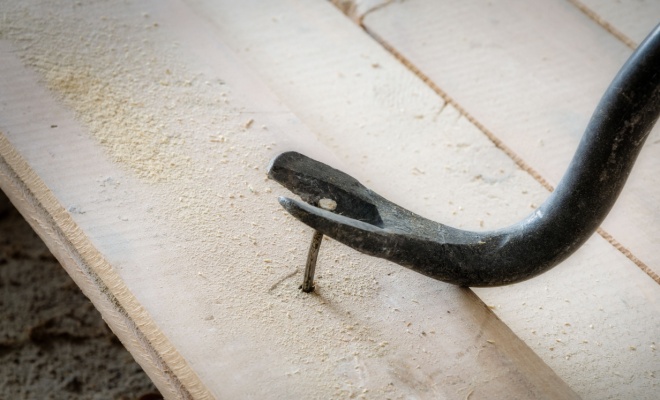
When you replace the floorboards, try to fill any gaps between and around them. Rugs and carpets on the floor will also keep your feet warmer, which may mean you don't need to turn on the heat as much.
Do not obstruct your walls' air bricks. They are required to help ventilate the space beneath your floor and prevent the floorboards from rotting. If you have a basement underneath your house that you can safely access, look down and see what kind of floor you have. If the floor is suspended, you will most likely see the wooden joists and the lower parts of the floorboards.
If you don't have access to the space beneath your house, you'll have to lift a corner of the carpet and underlay it to inspect it.
Lifting the floorboards and trying to lay mineral wool insulation supported by netting between the joists can be used to insulate timber floors. Insulating under the floorboards on your ground floor could save you £50 per year in a typical home or £85 in a detached house.
The project's location determines these. The U-value refers to the levels of thermal insulation required when performing building work, whether for new construction or renovation. The location, whether in England, Scotland, or Wales, the building type and whether it is domestic or non-domestic, and the application, such as the floor, wall, or roof. U values are typically expressed in terms of W/m2K.
Building Regulations for Floor Insulation
The ground floor accounts for approximately 10% of heat loss in the average home. As a result, insulation is typically installed on the ground floor to reduce heat loss. It may, however, be provided on upper floors between heated and unheated areas. Compared to wall or roof insulation, the waste elimination with floor insulation is more modest, but installation costs can be lower in some cases.
Floors must meet minimum thermal performance values, according to building codes. U-values, measure how quickly heat travels through the floor, which influences the amount of insulation needed. Within the UK in England, Wales and Northern Ireland, maximum U-value regulations for ground floors is 0.25 W/m²K whereas the maximum in Scotland is 0.18 W/m²K.
A U-value of 0.25 W/m2K or less, for example, would necessitate at least 70 mm of high-quality foam insulation or 150 mm of mineral wool, although that will vary based on floor type, construction, shape, and size.
This can be accomplished by installing approximately 70mm of foam board insulation or 150mm of blanket insulation.
Planning Permission for Floor Insulation
Usually, no planning permission is required for the installation of insulation (where there is no change in external appearance). However, if the structure is listed or in a conservation area, you should consult your local planning authority.
FAQs
How to Find & Hire a Floor Insulation Installer
Ask Family and Friends
There's a good possibility you know a few people who can recommend a reputable specialist. So, before you start searching the internet or checking your local listings, ask around to see if someone has any recommendations. Also, inquire with your co-workers, neighbours, friends, and family and ask if they have any recommendations.
Check Reviews
Online reviews are an excellent way to assess a labourer’s overall quality. Check the reviews and read some of the highest and lowest rating comments before hiring them to install insulation on your floor. This method will assist you in determining the reliability of the reviews and the quality and honesty of the tradesperson.
Ask For a Written Estimate
Once the specialist visits the job, ask for a written estimate. A written estimate is the closest thing to a warranty on what your insulation will cost. It's also a great way to avoid being ripped off because it allows you to shop around and compare the prices for other specialists in your area.
We recommend that you ask the following questions to tradespeople:
- Do you have a web presence? A website is not required, but it is beneficial because it may contain case studies, photographs of previous work, and customer feedback.
- Do you have a portfolio of your work with photos and customer testimonials? If the company or tradesperson does not have a website, ask if they have a portfolio where you can view photos and customer feedback.
- Do you belong to a trade organisation? For example, a professional insulation installer may be a National Insulation Association member (NIA).
- Does Public Liability Insurance cover you? Every tradesperson should have insurance.
- How much insulation installation experience do you have? If you need to know whether you're dealing with an experienced tradesperson or someone who has just finished training, ask this question.
Sources
https://www.planningportal.co.uk/permission/common-projects/insulation/planning-permission
https://www.doineedplanningpermission.co.uk/planning-information/insulation.aspx
https://energysavingtrust.org.uk/advice/floor-insulation/









